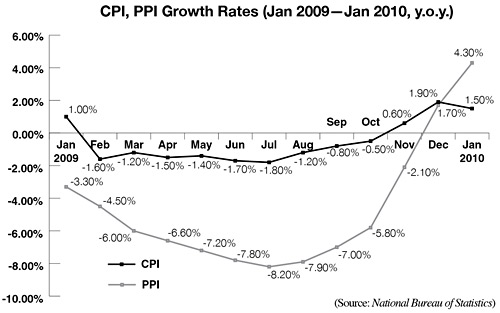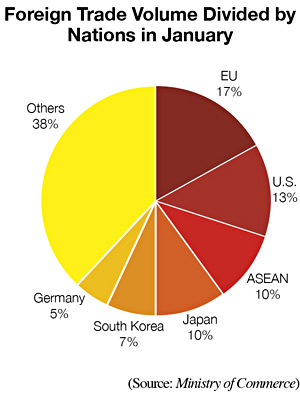| CPI
In January, consumer price index (CPI), a main gauge for inflation, rose 1.5 percent from a year earlier, the highest growth in nearly two years.
The price increase of food, rent, fuel and auto parts contributed most to the CPI growth.
Analysts estimated CPI growth would accelerate in the middle of this year when the economic recovery was reassured.
The mild CPI growth lowered people's expectations on imminent interest rate hikes. At present, the nominal one-year benchmark interest rate is 2.25 percent, still in the positive territory adjusted for inflation.
PPI
In January, producer price index (PPI), an inflation measurement at the wholesale level, grew 4.3 percent.
The upward trend of PPI indicated that the profits of enterprises would increase rapidly, said Wei Fengchun, a macro-economy analyst with China Securities Co.
The domestic price reform of major resource products and rising international commodity prices accelerated the PPI growth. The crude oil producer price soared 69.7 percent year on year in January, a major propellant for PPI growth.
Prices of ferrous metals and related products dropped 1.4 percent, led by price decreases in rolled steel plates and other rolled steel products.

Foreign trade

In January, China's foreign trade shrugged off the influences of the dismal global economy and picked up momentum of its own.
The total foreign trade volume in January this year rose 44.4 percent to $204.78 billion. The exports value stood at $109.47 billion, up 21 percent year on year. Total imports surged 85.5 percent to $95.31 billion.
The robust January figure was due to a low comparison base last year.
Due to strong imports, the trade surplus continued to decrease--to $14.16 billion, down 63.8 percent from that of January 2009.
In the first month of this year, the EU remained China's largest trade partner with bilateral trade reaching $35.18 billion, growing 26 percent. The United States was the second largest, followed by the Association of Southeast Asian Nations (ASEAN) and Japan.
FDI
In January, China acquired $8.13 billion in foreign direct investment (FDI), which grew 7.79 percent from a year earlier. Altogether 1,866 foreign-invested companies were approved to set up offices in China.
The January FDI in agriculture, forestry, animal husbandry and fishery industries grew the most--88.87 percent year on year. FDI in the service industry remained the biggest, accounting for 43.75 percent of total FDI.
Loans and Deposits
China's newly added yuan-denominated loans stood at 1.39 trillion yuan ($203.51 billion), which was 224.3 billion yuan ($32.84 billion) less than the same month last year.
The new loans were equivalent to the combined amount in the last quarter of 2009, igniting worries of excess liquidity and inflation pressure.
In spite of repeated efforts to reassure investors of the accommodative monetary policy, the central bank has in effect embarked on a journey to rein in bank loans. In January and February it hiked the reserve requirement ratio twice, freezing about 600 billion yuan ($87.85 billion). The ratio is the proportion of the money commercial banks must deposit into the central bank. At the end of February, the ratio for large financial institutions stands at 16.5 percent, while that of small financial institutions is 13.5 percent.
In January, newly added yuan-denominated deposits stood at 1.51 trillion yuan ($221.08 billion), down 4.2 billion yuan ($614.93 million).
Housing Price Surge
Housing prices in 70 large and medium-sized cities soared 9.5 percent in January year on year, the highest growth in 21 months, according to figures from the National Bureau of Statistics.
Cities with the highest growth included Haikou and Sanya on Hainan island. Fueled by the Central Government's plan to build Hainan into an international tourist destination, the housing prices in the two cities surged 35.1 percent and 31.2 percent respectively.
Jin Yanshi, chief analyst at Sinolink Securities Co. Ltd., predicted the housing prices will continue to grow and might double in the next five years.
Jin attributed the rising housing prices to excess money pumped into the market by the central bank. Jin said from 1992 until now, the money printed by the central bank grew 23 percent annually, while the economic growth was maintain around 10 percent, meaning a significant liquidity-pushed asset value.
(Figures from the National Bureau of Statistics, the Ministry of Commerce and the People's Bank of China) | 